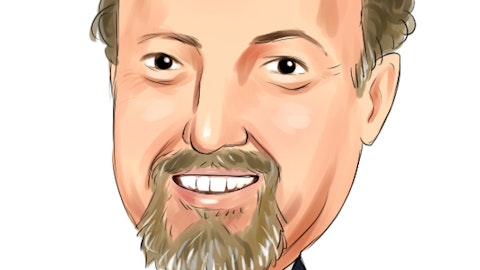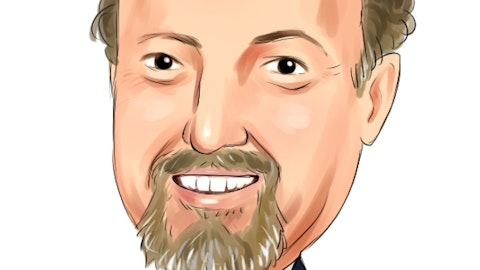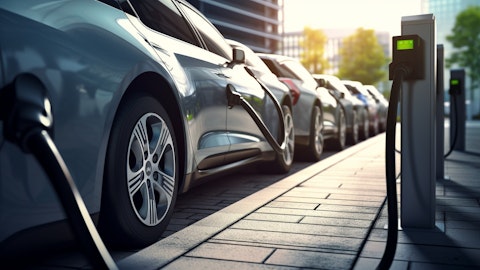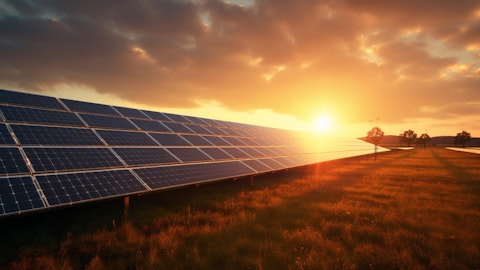Andy Marsh: Go ahead, Paul.
Paul Middleton: Yeah, I mean, it’s probably north of $300 million, something in that range, plus or minus. I mean, the first couple months are very encouraging in terms of what we’ve seen in curtailing the spend. And we’re laser focused on narrowing CapEx even further and deferring when we can and doing all the things that we talked about to drive that down. So…
Bill Peterson: Great. Thanks for all the color and insights. Thank you.
Andy Marsh: Thanks, Bill.
Operator: Thank you. Next question is coming from George Gianarikas from Canaccord Genuity. Your line is not live.
George Gianarikas: Hey, good morning, and thank you for taking my question.
Andy Marsh: Good morning, George.
George Gianarikas: So, I have sort of an existential question. As you recover in 2024 and digest some of the new rules from Treasury, what sort of focus should we expect from Plug Power long term? Which areas of the hydrogen market or geographies probably offer the best returns on capital as we focus beyond 2024? Thank you.
Andy Marsh: That’s actually a good question, George. And I think that — I think what you’ll see is that during the — and this is actually we’ve been spending a lot of time on this issue. I think through this decade that the energy business with electrolyzers as well as generation of hydrogen will probably represent two-thirds of our revenue during the rest of this decade. What we believe is that, come 2030, what you’re going to see is accelerated growth in our application business, especially our stationary products. And not to go way out there, George, but you said to me existential. I think by ’22 — by ’32, ’33, applications will start probably dominating again as more and more hydrogen is readily available. I think during the next two to three years, when the energy sector — Europe will actually dominate our electrolyzer sales.
And then, ultimately, I think that on that energy sector, the U.S. and Europe will start balancing more out. And that would be kind of what our internal view is as we look out through ’35. But obviously, our crystal ball is much better for ’24, ’25. So, it’s the energy sector, it’s Europe for electrolyzers, it’s the U.S. for applications. Hope that helped…
George Gianarikas: Thank you. Maybe as a follow-up, you announced, I think, about a week and a half ago a contract to support a major U.S. auto OEM in material handling. Curious as to whether you can share any more detail. I think you mentioned the first quarter of ’25 that’ll be operational. Any additional detail? Thank you.
Andy Marsh: It’s a new customer. It’s a U.S.-based customer. When we look at it, it is a perfect opportunity because it’s a campus which will include their suppliers, which also will be using hydrogen-based products, which will allow us to continue to grow. I hope during the coming quarters, we’ll be able to tell you more, but it’s a big deal. I think that there’s almost a dozen hydrogen fueling stations inside the building. And this is pretty typical how new buildings come up. Georgia, if I think about BMW in Spartanburg, where we started with about 75 products, and you’ll have initial run of those products and testing during the end — in this case, at this project at the end of the year, which duplicates what we’ve seen elsewhere with new auto facilities, and then it could rapidly grow.
At BMW, for example, I think we have over 600 fuel cells today. So, I think what you’ll see is this campus will continue to grow and I think will become bigger than BMW ultimately because of all the supplier base integrated there.
George Gianarikas: Great. Thank you so much.
Andy Marsh: You’re welcome, George.
Operator: Thank you. Next question is coming from Skye Landon from Redburn Atlantic. Your line is now live.
Skye Landon: Hi. Thanks for taking my questions.
Andy Marsh: Good morning, Skye.
Skye Landon: Hi, Andy. In the base case, my first question is, the 70% cash burn reduction guidance, does this assume any CapEx for new hydrogen projects in Texas or New York during 2024, or are these projects now in the base case of 2025 start? And then secondly, on the outlook for the electrolyzer business, when do you now expect to start seeing major projects reaching contracts-ready stages? And when do you expect to see order flow coming in? I mean, we’ve got production auctions going on in Europe at the moment. Hopefully, we’ll get some clarification on the rules in the U.S. But I’d be interested to hear your take on whether this is a first-half ’24 or second-half ’24, or a 2025 timing. Thank you.
Andy Marsh: I will let Sanjay take the electrolyzer first, and then I’ll turn it over to Paul for capital usage.
Sanjay Shrestha: Thank you, Andy. Hey, Skye. Again, on the electrolyzer side, right, so I’m sure you guys saw we announced that we actually did multiple basic engineering design package with some large customers in Europe in 2024. We have actually done a lot of those basic engineering design packages with customers throughout the world, if you would, even in 2023, right? So, when you think about our book of business or the work that we’re doing within the basic engineering design package that is actually approaching almost 4-gigawatt when you really think about that. Now, some of these projects needs to get to FID, but we’re working hand in hand with the customers, helping them think through the design, helping them think through what’s the optimal way to think about the plant build out.
And that’s where having built Georgia, having had 40 megawatt and the world’s largest PEM electrolyzer in the Western hemisphere actually goes a long way to support customers in terms of thinking through that basic engineering design package as well. Now, when it comes to the revenue, for 2024, we actually have a pretty robust backlog when you think about it, right? We have a lot of 5-megawatt projects already in the backlog. We also do have some large projects that we’re already executing that’s in the backlog. We do have 1 megawatt system in the backlog. So, ’24 is really about executing, really about delivering on that existing backlog and puts us in a really good position to be able to do a few things. One, convert the inventory into cash.
This business is really going to be our cash generation in 2024, as well as drive the top-line growth. The second piece you’re going to see in 2024, as we execute in this backlog, margins will not be as great in Q1. It will improve in Q2, but margins as well as cash flow will again improve in the second half of the year, as you start to see cost going down, as you also start to see higher price opportunity flow through that P&L. So, for 2024, it’s not so much about really going and winning more business, but we do feel pretty good about a lot of these projects where we have done basic engineering design package on 100-megawatt-plus project that starts to actually become concrete. There’s many projects going to FID by the middle of this year.
But let’s be clear, right, real revenue opportunity on this large project, whether it’s in Europe, whether it’s in U.S., whether it’s in Australia, that is really going to be 2025 and beyond opportunity, giving us a fantastic base of that backlog, very predictable revenue, very predictable margin. And in the near term, even to support growth in 2025, we’re also very focused on our 5-megawatt product line, both for U.S. as well as for Europe. And that’s where you will still see new book of business materialize for us supporting that growth in 2025. Again, we feel very good about cash generation, strong visibility. This year is really about executing on this existing backlog for us to give us a robust performance in the electrolyzer business in 2024.
Paul?
Paul Middleton: Yeah. And I guess a couple things. One, on the hydrogen investments that we have in the current plan is predominantly the retention and finalization of the Georgia plant that we’ve completed. It’s the funding for the Louisiana program we have with Olin that we’re developing, building, rolling out. And it’s kind of residual projects that we had open at the end of last year that we’re paying now for, given extended terms on some of the vendor programs. On Texas and New York, we already had spent a lot of money. We kind of tailed and tempered that in the near term until we turn on the right financing solutions. But given the money that we spent, it puts us in a good position that as we launch those, the new solution that we would launch would fund the majority, if not all, of that incremental spend. So, as we turn that on in the second half or into next year, we expect the majority of that to be covered with new financing.
Andy Marsh: We do have already, for example, in stock, things like the rectifiers, Paul, as well as the much of the electrolyzers, many of the electrolyzers as well as the fact of liquefiers, the Plug of liquefier.
Paul Middleton: Storage equipment, yeah, there’s a lot of things we already have.
Skye Landon: Perfect. That’s great color. Thank you.
Andy Marsh: Great. Eric, I think, is now jumping ahead of you, Kevin. Go ahead.
Operator: [Operator Instructions] Our next question is coming from Eric Stine from Craig-Hallum. Your line is now live.
Eric Stine: Good morning, everyone. Hey, I’ll just stick with one here towards the end of the call.
Andy Marsh: Good morning, Eric.
Eric Stine: Yeah, good morning. Hey. So for ’24, I can appreciate not guiding given the focus more on the cash side and the expense side. But just curious, longer term, when you balance that versus so many commercial opportunities, what’s going on with green hydrogen? When do you think that what year, is it ’25, is it ’26, when you get back on that more traditional growth path, the one you’ve been on for several years growing at a pretty rapid clip?
Andy Marsh: I’m going to let Paul take that, Eric. But I think Paul said in his remarks, we didn’t expect zero growth this year. That was part of Paul’s remarks. And I think if I was going to separate it out, the energy business, we expect to grow healthy this year. There’s always certain risk and timing in the project deployments. In the application business, I would expect that come ’25, as we have focused on getting our costs in line this year, but I would expect ’25, and I’m going to let Paul, and I think he probably made reference to it in his comments, we would expect that things get looking back to traditional performance. But this year, I think in my opening comments, I really made it clear, we are looking to continue to expand and grow this business but at better pricing and better margins. Paul, do you want to add?
Paul Middleton: Yeah. I think everything you said is right, Andy. And I guess the only thing I would add is that we don’t want to over-promise anything this year. But I certainly hope and believe that there’s lots of upside opportunities. So, as we work through the year and position ourselves for 2025, we think there’s definitely a chance it can, even though we’re kind of tempering incremental growth, we think there’s upside and certainly posturing towards even better growth as we move into ’25.
Andy Marsh: So, Eric, if I think about the electrolyzer business, nobody has a facility like we have. When you look about the ability to build plants, and I think that Sanjay can tell you for folks that we’ve been doing the design with, our talent in the Netherlands, who have been deeply involved in this activity, really is well respected. And so, I believe we’ve made the investments in the infrastructure to support large-scale build-outs and that really puts us in a unique strategic position versus the competition out there.
Eric Stine: Okay. That’s helpful. Thanks.
Andy Marsh: All right. Thanks, Eric.
Operator: Thank you. Next question is coming from Jordan Levy from Truist Securities. Your line is now live.
Jordan Levy: Yeah. Appreciate all the details. Maybe just to go back to kind of that last comment on the electrolyzer side, I recognize you’ve kind of built up the scale for the long term here, and it makes a lot of sense. But I’m just curious, as we think about going through this year, how do you — and maybe this is for Sanjay, how do you think about optimizing volumes coming out of that plant while you’re trying to reduce inventories and sort of what is the right run rate at this point in time to balance that equation?
Sanjay Shrestha: Great question. That’s something we’ve been spending obviously a lot of time thinking through, right? So, this year, again, it’s really about executing on the backlog. And there is a lot of inventory already in-house, right? We’re going to make sure that we use through that. So, this is really a focus on — just to think about it, right? There’s a — we have quite a bit of 5-megawatt product that’s already in the backlog, as I said. We have quite a bit of 1-megawatt product that’s already in the backlog. And with some of the strategic partners, we also do some strategic stack sales, right? So, when you really think about it, this year is not about optimizing the capacity utilization or the labor overhead per se.
It’s really more about using what we’ve already bought, all the procurement that has been made to execute on this project, right? So, the way you should think about it is, Q1 is going to start out somewhat similar to what the Q4 was like, but I think you will see a step change in that revenue as you go into Q2, Q3, and Q4, number one. You will see cash generation out of this business in every single one of these quarters, because we are burning through the existing inventory. And then, you will actually see a step change, not just in the revenue, but also in the margin as you start to go into the second half of the year as the cost comes down, as we work on this new stack design that actually also allows us to lower the cost of that stack that will start helping in Q3.
Then, cash generation with the improved margin profile will see a step change in Q3, another step change in Q4 as well for this year. So, it’s not about really needing to find more opportunity for electrolyzer business in 2024. It’s really about working hand in hand with customer, making sure that we go from what we refer to as the factory acceptance test, when the unit goes to the site, then you got to do the site acceptance test, and we’ve actually been having a lot of wonderful collaboration with a lot of different customers. In some cases, things have been challenging. We’re learning together, but I think we’ve come a long way here, which I think puts us in a pretty good position to deliver what is going to be a great cash generation and a really changing margin trajectory as you go through the year in this business.
That is not to say that we’re not going to do — continue to do new bookings. You will see new bookings coming on our 5-megawatt product line, both for U.S. as well as Europe. That will support growth in 2025. And then, just think about the opportunity that we have with this basic engineering design package approaching 4-gigawatts, that really puts us in a position where not just ’25, but we’re looking at very good backlog build going into ’26 and beyond as well as making this a very stable, predictable, high margin as well as a cash-generating business for us.





